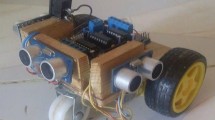Abstract
Various path or route solving algorithms have been widely researched for the last 30 years. It has been applied in many different robotic systems such as bomb sniffing robots, path exploration and search rescue operation. For instance, an autonomous robot has been used to locate and assist a person trapped in the jungle or building to exit. Today, numerous maze solving algorithms have been proposed based on the some information available regarding the maze or remotely control. In real scenario, a robot is usually placed in an unknown environment. It is required for the robot to learn the path, and exhibit a good decision making capability in order to navigate the path successfully without human’ assistance. In this project, an Artificial Intelligence (AI) based algorithm called Recursive Backtracking Depth First Search (RBDS) is proposed to explore a maze to reach a target location, and to take the shortest route back to the start position. Due to the limited energy and processing resource, a simple search tree algorithm has been proposed. The proposed algorithm has been evaluated in a robot that has the capability to keep track of the path taken while trying to calculate the optimum path by eliminating unwanted path using Cul-de-Sac technique. Experimental results have shown that the proposed algorithm can solve different mazes. The robot has also shown the capability to learn and remember the path taken, to return to the start and back to target area successfully.
Access this chapter
Tax calculation will be finalised at checkout
Purchases are for personal use only
Similar content being viewed by others
References
Abdullah, A.H., Lim, T.H.: SmartMATES for medication adherence using non-intrusive wearable sensors. In: Perego, P., Andreoni, G., Rizzo, G. (eds.) MobiHealth 2016. LNICST, vol. 192, pp. 65–70. Springer, Cham (2017). https://doi.org/10.1007/978-3-319-58877-3_8
Muhammad, N., Lim, T.H., Arifin, N.S.: Non-intrusive wearable health monitoring systems for emotion detection. In: 2017 12th IEEE Conference on Industrial Electronics and Applications (ICIEA), pp. 985–989 (2017)
Stentz, A.: Optimal and efficient path planning for partially known environments. In: Hebert, M.H., Thorpe, C., Stentz, A. (eds.) Intelligent Unmanned Ground Vehicles. The Springer International Series in Engineering and Computer Science (Robotics: Vision, Manipulation and Sensors), vol. 388, pp. 79–82. Springer, Boston (1997). https://doi.org/10.1007/978-1-4615-6325-9_11
Jiang, H.L.: Designed of Wheeled Robot Based on Single Chip Computer, vol. 13 (2009)
Elshamarka, I., Saman, A.: Design and implementation of a robot for maze-solving using flood-fill algorithm. Int. J. Comput. Appl. 56(5), 8–13 (2012)
Dang, H., Song, J., Guo, Q.: An efficient algorithm for robot maze-solving. In: 2010 Second International Conference on Intelligent Human-Machine Systems and Cybernetics, vol. 2, pp. 79–82 (2010)
Cahn, D.F., Phillips, S.R.: ROBNAV: a range-based robot navigation and obstacle avoidance algorithm. IEEE Trans. Syst. Man Cybern. SMC 5(5), 544–551 (1975)
Sadik, A.M.J., Dhali, M.A., Farid, H.M.A.B., Rashid, T.U., Syeed, A.: A comprehensive and comparative study of maze-solving techniques by implementing graph theory. In: International Conference on Artificial Intelligence and Computational Intelligence, vol. 1, pp. 52–56 (2010)
Cai, J., Wan, X., Huo, M., Wu, J.: An algorithm of micro mouse maze solving. In: 2010 10th IEEE International Conference on Computer and Information Technology, pp. 1995–2000 (2010)
Mishra, S., Bande, P.: Maze Solving Algorithms for Micro Mouse, pp. 86–93, January 2009
Wang, H., Yu, Y., Yuan, Q.: Application of Dijkstra algorithm in robot path-planning. In: Second International Conference on Mechanic Automation and Control Engineering, pp. 1067–1069 (2011)
Mishra, S., Bande, P.: Maze solving algorithms for micro mouse. In: 2008 IEEE International Conference on Signal Image Technology and Internet Based Systems, pp. 86–93 (2008)
Lee, C.Y.: An algorithm for path connections and its applications. IRE Trans. Electron. Comput. EC 10(3), 346–365 (1961)
Gupta, B., Sehgal, S.: Survey on techniques used in autonomous maze solving robot. In: 2014 5th International Conference - Confluence The Next Generation Information Technology Summit (Confluence), pp. 323–328 (2014)
Ginsberg, M.: Essentials of Artificial Intelligence. Elsevier Science (2011)
Adil, M.J.S., Maruf, A.D., Hasib, M.A.B.F.: A comprehensive and comparative study of maze solving techniques by implementing graph theory. In: International Conference on Artificial Intelligence and Computational Intelligence (2010)
Lim, T.H., Lau, H.K., Timmis, J., Bate, I.: Immune-inspired self healing in wireless sensor networks. In: Coello Coello, C.A., Greensmith, J., Krasnogor, N., Liò, P., Nicosia, G., Pavone, M. (eds.) ICARIS 2012. LNCS, vol. 7597, pp. 42–56. Springer, Heidelberg (2012). https://doi.org/10.1007/978-3-642-33757-4_4
Lim, T.H., Bate, I., Timmis, J.: A self-adaptive fault-tolerant systems for a dependable wireless sensor networks. Des. Automat. Embedded Syst. 18(3–4), 223–250 (2014)
Author information
Authors and Affiliations
Corresponding author
Editor information
Editors and Affiliations
Rights and permissions
Copyright information
© 2021 ICST Institute for Computer Sciences, Social Informatics and Telecommunications Engineering
About this paper
Cite this paper
Lim, T.H., Ng, P.L. (2021). Evaluating Recursive Backtracking Depth-First Search Algorithm in Unknown Search Space for Self-learning Path Finding Robot. In: Shi, S., Ye, L., Zhang, Y. (eds) Artificial Intelligence for Communications and Networks. AICON 2020. Lecture Notes of the Institute for Computer Sciences, Social Informatics and Telecommunications Engineering, vol 356. Springer, Cham. https://doi.org/10.1007/978-3-030-69066-3_47
Download citation
DOI: https://doi.org/10.1007/978-3-030-69066-3_47
Published:
Publisher Name: Springer, Cham
Print ISBN: 978-3-030-69065-6
Online ISBN: 978-3-030-69066-3
eBook Packages: Computer ScienceComputer Science (R0)




